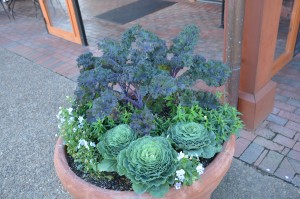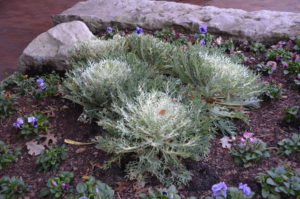Ornamental cabbage and kale (Brassica oleracea) are very close related to the same vegetables that we eat at our kitchen table. They are edible, just not as tasty. Plants are biennials, e.g. they produce leaves one year and flower the following spring. Ornamental kales have deeply cut serrated or ruffled leaves while leaves of ornamental cabbage are rounded leaves. Rosy to creamy white leaf colors are at their finest in full sun and temps fall into the upper 20’s and low 30’s.
Plants grow 18 inches tall and wide in either full to partial sun. When grown in warmer climes (zones 8 and warmer), partial shade is preferable. Kales and cabbages prefer a moderate acidic soil pH between 5.8 – 6.5. Irrigate plants weekly if rainfall is subpar.
By early spring plants have bolted (flowered), and leaves become torn and ragged. Aphids, cabbage loopers, and leaf rollers are troublesome in many growing areas. Mildew may cover leaves if fall weather is warm and humid. Cabbage loopers may destroy the foliage. An “owlet moth” deposits her eggs on foliage and the green worms (larval stage) quickly chew into the leaves. Frequent spraying with Sevin® or dusting with Bt (Bacillus thuringiensis), a natural bactericide, is effective. Insects are fewer in the cooler months. Rabbits are a secondary problem and should be fenced out.
Plants are very heavy feeders, and should be fertilized frequently for optimum growth. Plants properly hardened off plants can usually survive most winters in zones 7b and points further south. Drastic sub-freezing dips in temperature may burn leaf edges. Ice storms can destroy the planting.
I strongly urge the purchase of one gallon size plants over six packs of 4-inch pots. Smaller plants rarely reach full size before the biting cold wintry air arrives.
Leading varieties:
Kale:
‘Red Bor’ grows up to 3 feet tall with deep purple ruffled leaves.
‘Peacock Red’ and ‘Peacock White’ form large open plants up to 2 feet across with feathery leaves.
‘Red Feather’ and ‘White Feather’, similar to ‘Peacock Red’ except leaves are larger and less serrated.
‘Nagoya Red’ and ‘Nagoya White’ strut heavily ruffled foliage.
Cabbage: ‘Osaka Red’, ‘Osaka Pink,’ and ‘Osaka White’ – colorful wavy-edged leaves on tightly packed, 12 inch high compact heads. Top center rosettes turn bright purple, pink, or white with green outer leaf edges.



 Posted in
Posted in 
